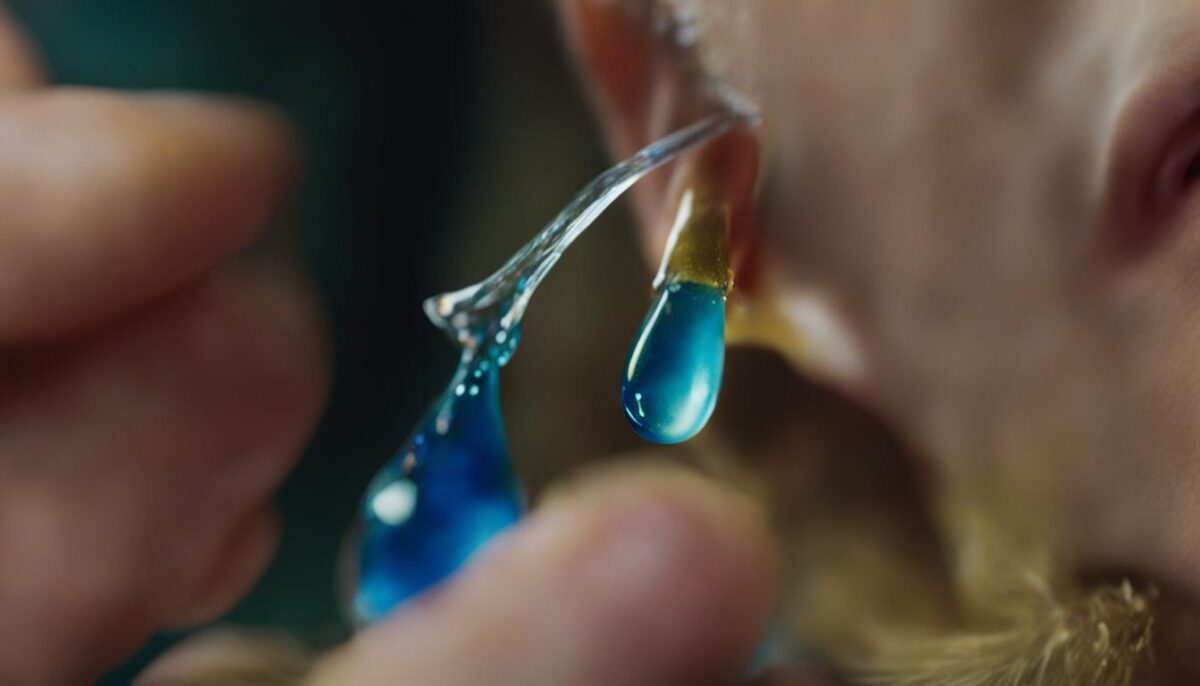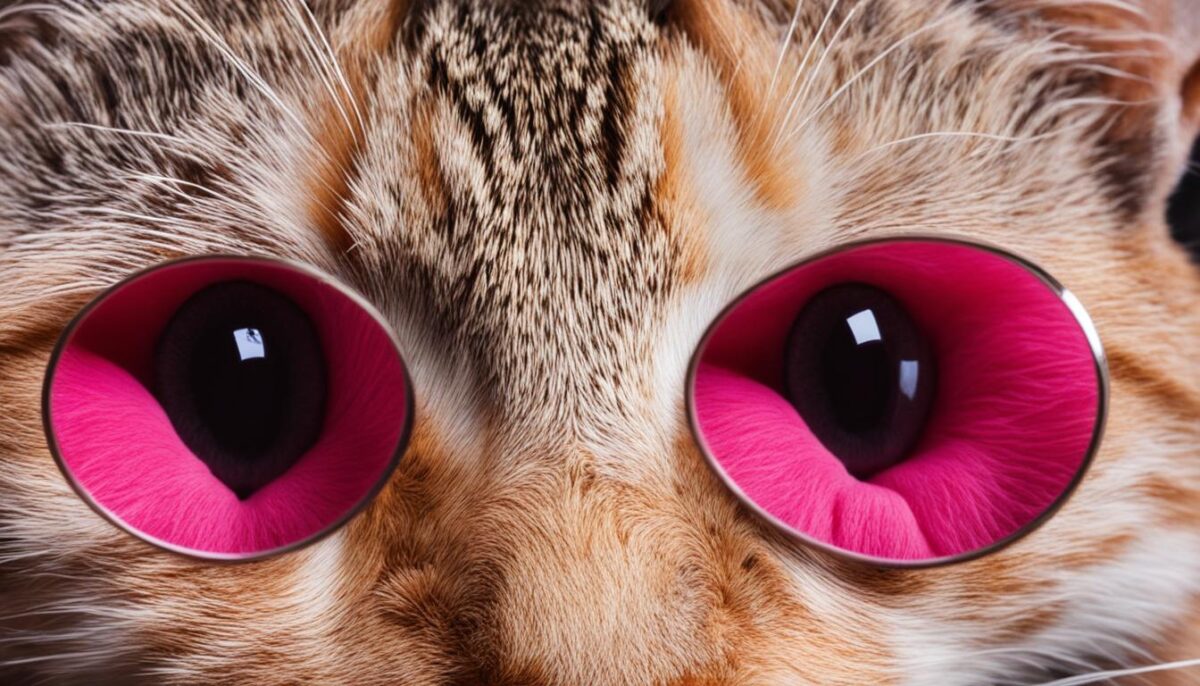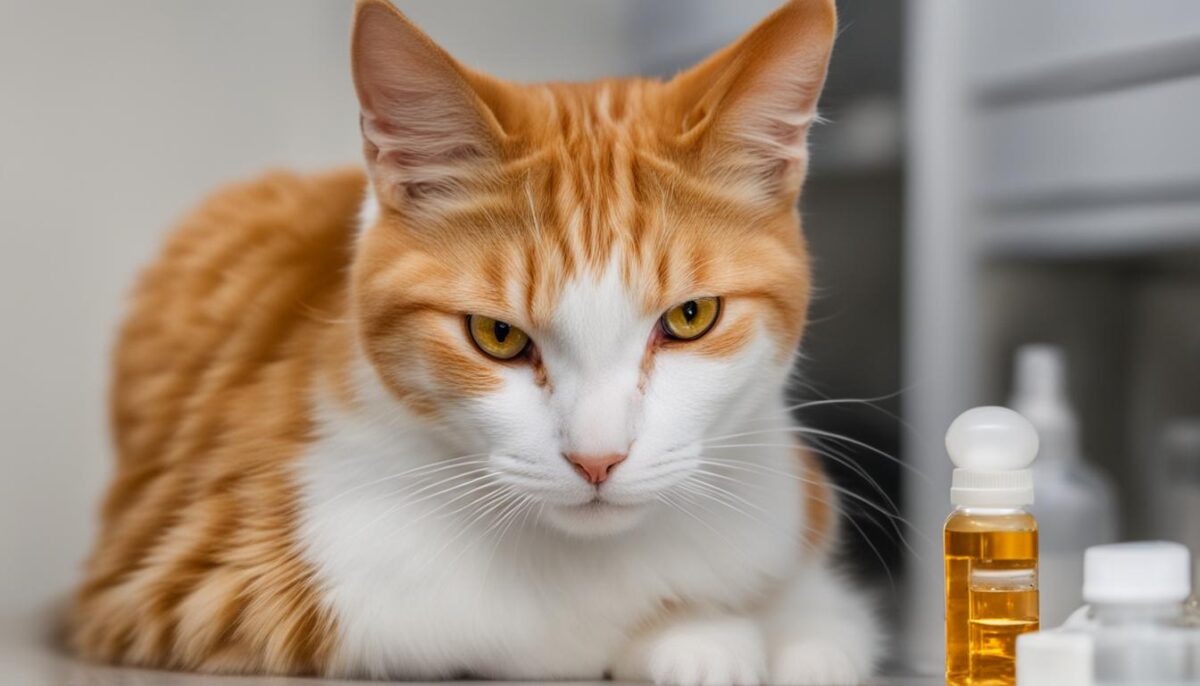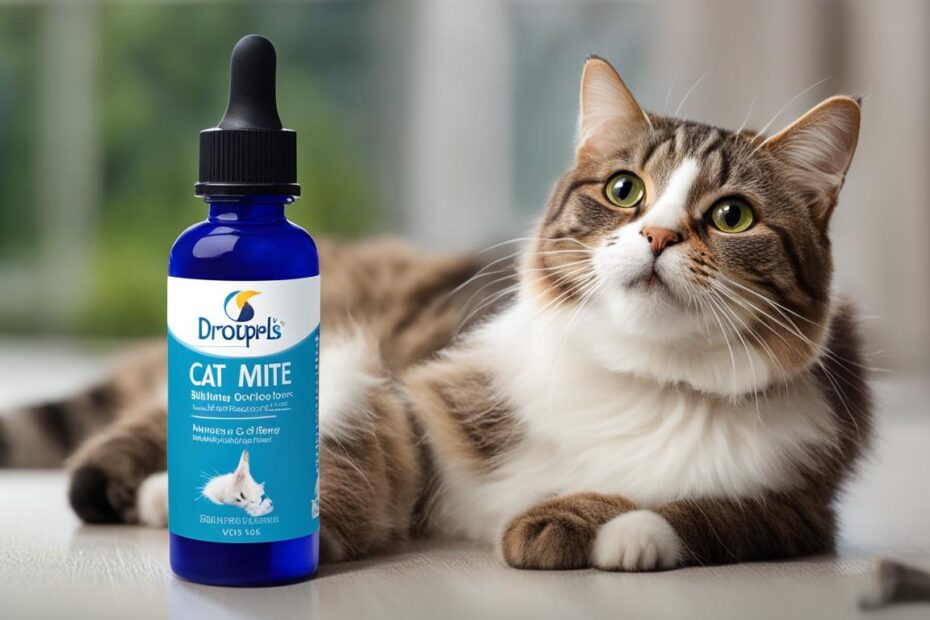Dealing with ear mites can be a distressing experience for both cats and their owners. These tiny parasites can cause irritation, itching, and discomfort for our feline friends. Finding an effective ear mite treatment is crucial to ensure your cat’s well-being and restore their ear health.
When it comes to combating cat ear mites, the right ear mite drops can make a significant difference. With a wide range of products available, it’s important to choose the best drops for cat ear mites that are both safe and effective for your furry companion.
One highly recommended option is PetArmor Medication for Ear Mites for Cats. This product contains active ingredients such as pyrethrins and piperonyl butoxide, which effectively combat ear mite infestations and soothe itching and inflammation of the ears. It is a trusted choice among cat owners and has received positive reviews for its efficacy.
In addition to PetArmor, other top picks for cat ear mite drops include Adams Medication for Ear Mites for Dogs & Cats, Hartz Medication for Ear Mites, Revolution Topical Solution for Cats, Arava Natural Ear Mite Treatment, and Zymox Otic Pet Ear Treatment with Hydrocortisone. These products offer different features and. It is important to choose the one that suits your cat’s needs.
Key Takeaways:
- Ear mites can cause discomfort and irritation in cats.
- PetArmor Medication for Ear Mites for Cats is a highly recommended choice.
- Other top picks for cat ear mite drops include Adams Medication for Ear Mites for Dogs & Cats, Hartz Medication for Ear Mites, Revolution Topical Solution for Cats, Arava Natural Ear Mite Treatment, and Zymox Otic Pet Ear Treatment with Hydrocortisone.
- Choose an ear mite treatment that soothes itching, eliminates infestations, and promotes ear health.
- Consult a veterinarian for guidance in selecting the best cat ear mite drops for your pet’s specific needs.
Understanding Ear Mites in Cats
Ear mites, scientifically known as Otodectes cynotis, are microscopic parasites that infest the ears of cats. These tiny mites live in the ear canals and feed on ear debris, causing irritation and discomfort for our feline friends.
When a cat has an ear mite infestation, they may exhibit various signs and symptoms. Some common symptoms of ear mites in cats include:
- Brown or reddish-brown discharge in the ears
- Dark waxy crusts inside the ears
- Foul odor coming from the ears
- Excessive head shaking or scratching of the ears
- Hair loss around the ears
It’s essential to recognize these signs as they can often be mistaken for other ear infections. If left untreated, ear mites can lead to secondary infections and more severe health issues for your cat.
One crucial aspect to note about ear mites is their contagious nature. Ear mites in cats are highly contagious and can easily spread from one cat to another, even through casual contact. If you have multiple pets in your household, it is recommended to treat all of them, even if they aren’t showing symptoms, to prevent the spread and recurrence of ear mites.
Properly diagnosing ear mites is essential to provide adequate treatment for your cat. If you suspect your cat has an ear mite infestation, it is best to consult with a veterinarian. They can perform a thorough examination of the ears and diagnose the presence of ear mites or any other ear-related issues.

Treating All Pets in the Household
To prevent reinfestation, it is highly recommended to treat all pets in the household, even if they do not show any symptoms of ear mites. Ear mites can easily spread between pets, so treating all animals simultaneously helps ensure the elimination of mites and reduce the risk of further infestations.
Consulting a Veterinarian
If you are unsure or uncomfortable with applying treatments on your own, it is always advisable to consult a veterinarian. They can provide expert guidance, perform a thorough examination, and recommend the most appropriate cat ear mite treatment for your furry friend’s specific needs.
Differentiating Ear Mites from Ear Infections in Cats
It can be challenging to differentiate between ear mites and ear infections in cats as they share similar symptoms. However, understanding the key differences can help in proper diagnosis and treatment.
Symptoms of Ear Infections in Cats
Ear infections in cats are characterized by inflammation of the external ear canal accompanied by itching, discharge, and a foul odor. Common symptoms include:
- Redness and swelling in the ear
- Excessive scratching or rubbing of the ears
- Discharge from the ears, which may be yellow or brown
- Unpleasant odor coming from the ears
- Pain or sensitivity when the ears are touched
Causes of Ear Infections in Cats
There are several causes of ear infections in cats:
- Ear Mites: Ear mites are one of the most common causes of ear infections in cats. These mites are highly contagious and can cause intense itching and irritation.
- Allergies: Cats can develop allergies to certain foods, environmental factors, or other substances, leading to ear infections.
- Bacteria or Yeast: Bacterial or yeast infections can occur in the outer ear canal, especially in cats with floppy ears or those who swim frequently.
- Fungal Infections: Fungal infections, such as ringworm, can also cause ear infections in cats.
When in doubt, it is best to consult a veterinarian for a proper diagnosis. They can examine the cat’s ears, perform tests if necessary, and recommend an appropriate treatment plan.

Comparison of Ear Mites and Ear Infections in Cats
| Ear Mites | Ear Infections | |
|---|---|---|
| Symptoms | Intense itching, dark discharge, head shaking, presence of mites | Inflammation, itching, discharge, foul odor |
| Cause | Parasitic infestation (ear mites), though other factors can contribute | Ear mites, allergies, bacteria, yeast, or fungal infections |
| Treatment | Specific ear mite treatment, cleaning, and prevention methods | Veterinary-prescribed medications, cleaning, and addressing underlying causes |
| Contagiousness | Highly contagious and can spread to other pets in the household | Not contagious, unless caused by ear mites |
Herbal Remedies for Ear Mites in Cats
While there are several effective cat ear mite drops available on the market, some pet owners may prefer natural remedies to treat their feline friends. Herbal remedies such as apple cider vinegar and coconut oil can be used as alternative treatments for ear mites in cats.
Apple Cider Vinegar
Apple cider vinegar is a popular home remedy known for its antibacterial and antifungal properties. To use apple cider vinegar for ear mites in cats, mix equal parts of apple cider vinegar and water. Using a clean dropper, apply a few drops of the mixture into your cat’s ear, gently massaging the base of the ear to ensure it reaches the affected area. Repeat this process once or twice a day until the ear mites are eliminated.
Coconut Oil
Coconut oil is another natural remedy that can help soothe the symptoms of ear mites in cats. Before using coconut oil, warm it to a liquid state. Using a clean dropper, apply a few drops of coconut oil into your cat’s ear canal and gently massage the base of the ear to distribute the oil. The antimicrobial and moisturizing properties of coconut oil can help alleviate itching and inflammation caused by ear mites. Repeat this process once a day until the ear mites are resolved.
Note: It is important to note that while natural remedies can be beneficial, they may not be as effective as over-the-counter cat ear mite drops that contain specific active ingredients. Additionally, essential oils should not be used as they can be toxic to cats.

How to Use Cat Ear Mite Drops
Properly applying cat ear mite drops is essential for effective treatment. Follow these guidelines to ensure the best results.
- Cleanse the ears: Before applying the drops, gently clean your cat’s ears with a veterinarian-approved ear cleaner. This helps remove debris and aids in the absorption of the medication.
- Read the instructions: Carefully read the instructions provided with the cat ear mite drops. Each product may have specific dosage instructions and recommended frequency of application. Always follow these instructions for optimal results.
- Administer the drops: Hold your cat securely and tilt their head slightly to one side. Carefully drop the prescribed number of drops into the ear canal. Be cautious not to insert the dropper too deep to avoid injuring your cat’s ear.
- Massage the base: Gently massage the base of your cat’s ear for approximately 30 seconds. This helps distribute the medication and ensures it reaches the affected areas.
- Repeat the process: Repeat the application process for the other ear, if necessary. Keep in mind that some cats may require treatment in both ears, even if only one is showing symptoms.
Throughout the treatment, it is important to maintain good hygiene practices. Wash your hands thoroughly after each application to prevent cross-contamination. If you have any concerns or questions, consult your veterinarian for specific instructions tailored to your cat’s condition.
Properly using cat ear mite drops is vital for treating and eliminating ear mites. By following the instructions and tips provided, you can ensure the well-being of your feline companion.
| Dosage Instructions | Application Frequency | Treatment Duration |
|---|---|---|
| 3 drops per ear | Twice daily | Until mites are eliminated |
Conclusion
When it comes to treating cat ear mites, choosing the right cat ear mite drops is crucial for your pet’s health and well-being. Ear mites can cause discomfort and irritation for cats, but they can be effectively eliminated with the proper treatment.
Our top recommendation for cat ear mite drops is PetArmor Medication for Ear Mites for Cats. This product stands out for its affordability, effectiveness, and popularity among cat owners. It contains active ingredients that effectively target the mite infestation and soothe itching and inflammation.
Proper diagnosis of ear mites is important before starting treatment, as they can be easily mistaken for other ear infections. It is best to consult a veterinarian for a proper diagnosis and to receive guidance on the appropriate treatment options for your cat.
When using cat ear mite drops, it is essential to carefully follow the instructions provided with the product. Apply the recommended dosage to each ear as instructed, and wash your hands thoroughly after application. By choosing the right cat ear mite drops and following the recommended treatment, you can ensure your cat’s ears are healthy and free from mites.
FAQ
What are ear mites and how do they affect cats?
Ear mites, scientifically known as Otodectes cynotis, are microscopic parasites that live in and around the ears of cats. They can cause symptoms such as brown or reddish-brown discharge, dark waxy crust, foul odor, head shaking, and hair loss around the ears. Ear mites are highly contagious and can be passed to other pets in the household.
How can I treat ear mites in cats?
When treating ear mites in cats, it is important to start with a thorough cleaning of the cat’s ears using a high-quality ear cleaner. After cleaning, topical medication with antiparasitic ingredients like ivermectin or cat-safe insecticides like pyrethins can be applied. It is recommended to treat all pets in the household, even if they don’t show symptoms, to prevent reinfestation.
How can I differentiate ear mites from ear infections in cats?
It can be challenging to differentiate between ear mites and ear infections in cats as they share similar symptoms. Ear infections in cats are characterized by inflammation of the external ear canal accompanied by itching, discharge, and a foul odor. The most common cause of ear infections in cats is ear mites, though allergies, bacteria, yeast, or fungal infections can also be responsible. When in doubt, it is best to consult a veterinarian for a proper diagnosis.
Are there any natural remedies for treating ear mites in cats?
Some pet owners prefer natural remedies for treating ear mites in cats. Apple cider vinegar can be mixed with water and applied to the cat’s ears to help control minor infestations. Coconut oil can also be warmed and massaged into the ears. However, it is important to avoid essential oils as they can be toxic to cats.
What are some recommended ear mite drops for cats?
Our top recommendation for cat ear mite drops is PetArmor Medication for Ear Mites for Cats. Other recommended products include Adams Medication for Ear Mites for Dogs & Cats, Hartz Medication for Ear Mites, Revolution Topical Solution for Cats, Arava Natural Ear Mite Treatment, and Zymox Otic Pet Ear Treatment with Hydrocortisone. These products have different active ingredients and features, providing a range of options for cat owners.
How do I use cat ear mite drops?
When using cat ear mite drops, it is important to follow the instructions provided with the product. Typically, a few drops are applied to each ear twice daily until the mites are eliminated. It is also important to wash hands thoroughly after application. It is recommended to consult a veterinarian for specific instructions and to ensure the proper use of the product.
What are the benefits of using cat ear mite drops?
Cat ear mite drops are an effective way to eliminate ear mites and alleviate the discomfort they cause. They can help soothe itching and inflammation, reduce discharge and odor, and prevent reinfestation. Using cat ear mite drops along with proper ear cleaning and treating all pets in the household can help ensure a successful treatment outcome.

